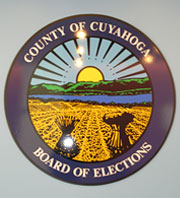Election 2008
Back to the Paper Age in Ohio
Mhari Saito
JANUARY 26, 2008
- The Cuyahoga County Board of Elections seal.
- (Mhari Saito)
- View the Slideshow
Web Resources
Related Stories
- Sober Up and Fly Right
- Fighting to Throw the Race
- Mike Gravel, Still in the Running
- Voting Rights: Release or Restrict?
More From Mhari Saito
No one really wants to spend part of their weekend in a city hall basement with 19 strangers doing nothing for an hour. But that's just what I found when I walked into such a meeting room recently in Lyndhurst, Ohio, a suburb of Cleveland.
"I'm a reporter. They told me to show up here for poll worker training," I said, bewildered.
"Well, we're here," said one person. "The instructor never showed up."
Like the others, 78-year-old Janice Beck came to training to find out if what she'd read in the newspaper was true: with just weeks to go before the Ohio primary, Cuyahoga County was tossing the electronic voting machines they've been using since 2005.
"Now they are going back to paper," she says. "I understand, but we were trained before on the touch-tone machines. Now we're going back, I don't know what to expect. I thought it would be interesting to know what they are going to do now."
Cuyahoga County's three-year history with electronic voting machines has been interesting more for its mishaps than its successes. Ohio already had a reputation following the 2004 election, after record turnout led to long lines in local precincts. But when electronic voting machines came online in 2005, results were still delayed thanks to lost memory cards and confused poll workers. Then in November of last year, things got bad.
"Barely anyone shows up to the poll. There are no lines everyone gets to vote," recalls Kymberli Hagelberg, who covers politics for Cleveland Public Radio. "[Then] two hours after polls close, the servers crash. I mean, they go down, they freeze completely--the servers for tabulating the votes."
It was too much for Ohio's new secretary of state. The Democrat cast a tie-breaking vote to scrap electronic voting units and use paper ballots. Now the county is trying to set up 350 classes to train people for the change. Jane Platten is in charge of that effort.
In her office, I mention that I showed up for poll-worker training, but the trainer did not.
"Oh, my God. Great," Platten says sarcastically. "You know, it's the human element. That's why poll workers are so important to us. They have to understand the process because the element of human error in this system. That is what's going to cause a vote not to be counted."
"You know what's funny," I say. "You talk about human error, and you think, we'll bring in the electronic voting machines, and that will eliminate that human error."
"Oh, my gosh, no way," Platten says. "Nope. Except for the server crash in November, most of the errors we dealt with were memory cards that didn't come back. It was too much. Now it's a simpler process."
After I talk with Jane Platten, I head downstairs to catch poll worker training, this time with a trainer.
"We've got a lot of new changes," he tells the group. "The big thing the Board of Election is focusing on is customer service�"
Training with the electronic voting units used to take over four hours, and a lot of time was spent on setting up the machines. At this training session, the trainer pulls out two battered metal suitcases, one blue and one black, and asks for volunteers.
A couple of people get up, open the cases and take out metal poles. The poles screw into the base of the suitcases and turn into legs. The case opens up, some side flaps pop in, and the suitcase turns into a rather flimsy looking voting booth. This is where voters will fill in their ballots. Then, workers will bring the votes back downtown, where they will be read by an optical scanner.
"It took us less than two minutes. We got it? It took us less than two minutes!" the trainer exclaims.
There's something amazingly underwhelming about the lean-to voting machines the class just assembled. One poll worker next to me whispers that they look cheap.
Janice Beck found the electronic voting machines intimidating and is glad to be going back to paper. Still, after she has her training session, she says she still feels cheated. Electronic voting machines cost Cuyahoga County $21 million.
"They spent an awful lot of money, our taxpayer money, for those machines not to work," Beck says. "And so abruptly, they had to turn around and go backwards instead of forwards, back to paper."
Ohio's primary is on March 4. New equipment for that election is estimated to cost $2.5 million.







Comments
Comment | Refresh
Post a Comment: Please be civil, brief and relevant.
Email addresses are never displayed, but they are required to confirm your comments. All comments are moderated. Weekend America reserves the right to edit any comments on this site and to read them on the air if they are extra-interesting. Please read the Comment Guidelines before posting.
You must be 13 or over to submit information to American Public Media. The information entered into this form will not be used to send unsolicited email and will not be sold to a third party. For more information see Terms and Conditions and Privacy Policy.